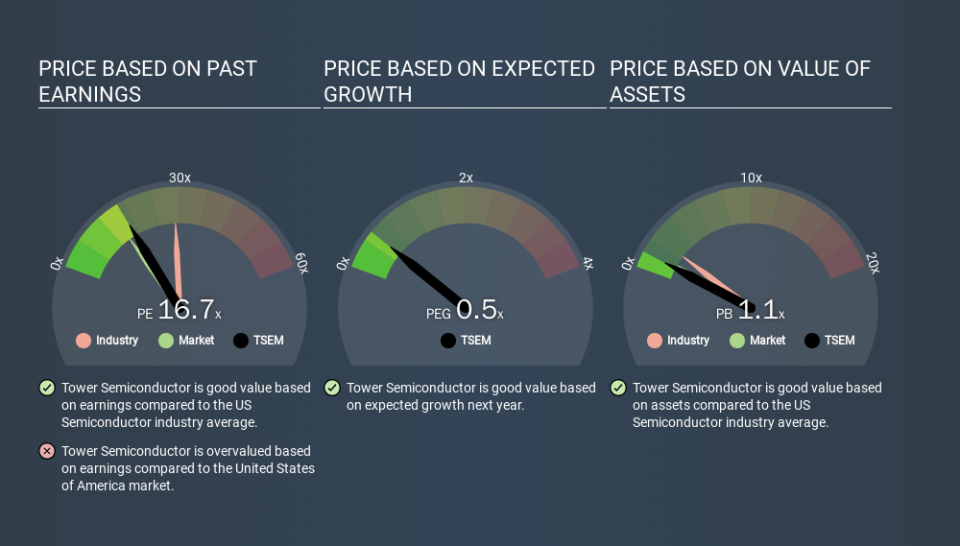A Sliding Share Price Has Us Looking At Tower Semiconductor Ltd.'s (NASDAQ:TSEM) P/E Ratio

Unfortunately for some shareholders, the Tower Semiconductor (NASDAQ:TSEM) share price has dived 43% in the last thirty days. The recent drop has obliterated the annual return, with the share price now down 14% over that longer period.
All else being equal, a share price drop should make a stock more attractive to potential investors. In the long term, share prices tend to follow earnings per share, but in the short term prices bounce around in response to short term factors (which are not always obvious). So, on certain occasions, long term focussed investors try to take advantage of pessimistic expectations to buy shares at a better price. One way to gauge market expectations of a stock is to look at its Price to Earnings Ratio (PE Ratio). A high P/E implies that investors have high expectations of what a company can achieve compared to a company with a low P/E ratio.
Check out our latest analysis for Tower Semiconductor
How Does Tower Semiconductor's P/E Ratio Compare To Its Peers?
Tower Semiconductor's P/E of 16.69 indicates relatively low sentiment towards the stock. We can see in the image below that the average P/E (25.2) for companies in the semiconductor industry is higher than Tower Semiconductor's P/E.
Its relatively low P/E ratio indicates that Tower Semiconductor shareholders think it will struggle to do as well as other companies in its industry classification. Many investors like to buy stocks when the market is pessimistic about their prospects. You should delve deeper. I like to check if company insiders have been buying or selling.
How Growth Rates Impact P/E Ratios
When earnings fall, the 'E' decreases, over time. Therefore, even if you pay a low multiple of earnings now, that multiple will become higher in the future. So while a stock may look cheap based on past earnings, it could be expensive based on future earnings.
Tower Semiconductor saw earnings per share decrease by 37% last year. But EPS is up 59% over the last 5 years. And EPS is down 29% a year, over the last 3 years. This growth rate might warrant a low P/E ratio.
Remember: P/E Ratios Don't Consider The Balance Sheet
The 'Price' in P/E reflects the market capitalization of the company. So it won't reflect the advantage of cash, or disadvantage of debt. Hypothetically, a company could reduce its future P/E ratio by spending its cash (or taking on debt) to achieve higher earnings.
Spending on growth might be good or bad a few years later, but the point is that the P/E ratio does not account for the option (or lack thereof).
How Does Tower Semiconductor's Debt Impact Its P/E Ratio?
Tower Semiconductor has net cash of US$514m. This is fairly high at 34% of its market capitalization. That might mean balance sheet strength is important to the business, but should also help push the P/E a bit higher than it would otherwise be.
The Bottom Line On Tower Semiconductor's P/E Ratio
Tower Semiconductor trades on a P/E ratio of 16.7, which is above its market average of 13.3. Falling earnings per share is probably keeping traditional value investors away, but the healthy balance sheet means the company retains the potential for future growth. If this growth fails to materialise, the current high P/E could prove to be temporary, as the share price falls. Given Tower Semiconductor's P/E ratio has declined from 29.1 to 16.7 in the last month, we know for sure that the market is significantly less confident about the business today, than it was back then. For those who don't like to trade against momentum, that could be a warning sign, but a contrarian investor might want to take a closer look.
Investors have an opportunity when market expectations about a stock are wrong. If the reality for a company is better than it expects, you can make money by buying and holding for the long term. So this free visualization of the analyst consensus on future earnings could help you make the right decision about whether to buy, sell, or hold.
Of course, you might find a fantastic investment by looking at a few good candidates. So take a peek at this free list of companies with modest (or no) debt, trading on a P/E below 20.
If you spot an error that warrants correction, please contact the editor at editorial-team@simplywallst.com. This article by Simply Wall St is general in nature. It does not constitute a recommendation to buy or sell any stock, and does not take account of your objectives, or your financial situation. Simply Wall St has no position in the stocks mentioned.
We aim to bring you long-term focused research analysis driven by fundamental data. Note that our analysis may not factor in the latest price-sensitive company announcements or qualitative material. Thank you for reading.

